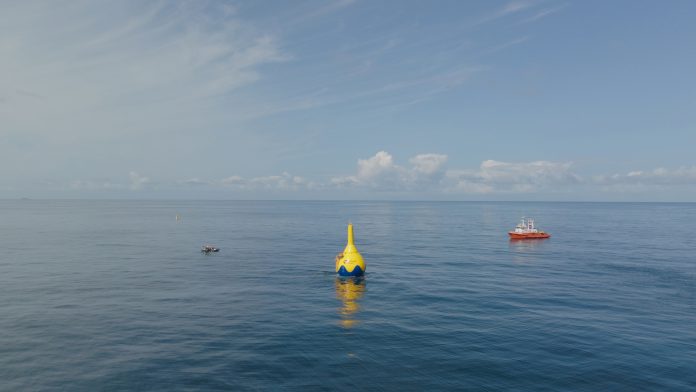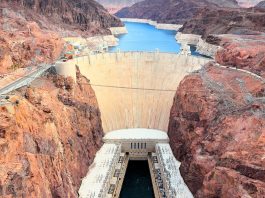Amy Parsons, Communications and Events Director at Ocean Energy Europe, explains why now is the right time for Europe to accelerate its role in the ocean energy space.
In the Raz Blanchard, or Alderney Race, the ocean is funnelled through a narrow passage between the Channel Islands and Normandy. While its strong currents mean it is a famously challenging route for seafarers, they also make it one of the world’s best tidal energy sites. The power of this high-velocity tidal ‘stream’ can be captured by the latest generation of tidal turbines, which can sit on the seabed or float near the surface.
Ocean waves and swells, the thermal energy of warmer waters, and even the salinity of seawater, can also be exploited to generate clean, infinite electricity. Together with tidal stream energy, these technologies are collectively known as ‘ocean energy’ – and they are amongst the most cutting-edge innovations available anywhere in the world.
Recognising the huge potential for producing clean electricity from the sea, the French government has recently announced support of at least €65m to install a groundbreaking tidal energy farm, FloWatt, in the Raz Blanchard. Using innovative technology from French tidal developer HydroQuest, FloWatt will be the biggest tidal farm in the world, with the most turbines and largest capacity – a true flagship project. On top of the substantial grant, the ocean energy project will receive vital revenue support in the form of a feed-in tariff (FIT).
Having a guaranteed energy price for the electricity produced is a key ask of the ocean energy sector, as it levels the playing field and gives projects long-term visibility – which, in turn, brings in more private investment.
In the UK, the government has also stepped up when it comes to this all-important revenue support. A ringfenced budget of £20m for tidal energy projects was included in the 2022 ‘Contracts for Difference’ auction – the UK’s revenue support mechanism for low-carbon electricity production projects. This will enable the development of three tidal energy projects that will generate over 40 MW of electricity for British homes and businesses. The next round of auctions will maintain similar funding levels dedicated to supporting tidal energy.
The EU: Putting its money where its mouth is
Meanwhile, EU funding of €40m has recently been awarded for the development of two tidal energy farms via the Horizon Europe funding programme, with the same amount also earmarked for two wave energy pilots in 2024. These grants target utility-scale, multi-device demonstration projects, which will then open the door to full-scale commercial deployment.
The other big win for ocean energy in 2023 came with the news that the EU Innovation Fund has awarded funding to a wave energy project in Ireland and a hybrid wind-wave project located in Spain. Claiming two of nine available spots in the ‘mid-sized pilot’ category, each project is entitled to receive up to a maximum of €40m.
The Saoirse project, led by developer Simply Blue Group, will be the first full-scale wave energy conversion test and demonstration project in Ireland. The 5MW farm, located 4km off the coast of County Clare, will consist of approximately 15 wave energy converter units.
Floating Power Plant’s ‘Seaworthy’ project will demonstrate a dispatchable renewable power supply through smart integration of wave energy converters, a wind turbine, and a hydrogen system on a single platform, to be deployed in Spanish waters.
National governments must now mirror EU support for ocean energy
‘Blended’ financing, which mixes grant funding, revenue support and private investment, is the catalyst that will get large-scale ocean energy projects into the water. Whilst the recent EU, French and British funding announcements are encouraging, a lack of revenue support and long-term political visibility is a threat to the rollout of ocean energy projects in many other European countries.
And this is a threat we cannot afford to deal with right now. Skyrocketing gas prices and political instability have put Europe’s dependency on imported fossil fuels front-and-centre over the past two years. The global economy is taking the hit, citizens and businesses are struggling to pay their bills, and industrial production growth is stagnating. At the same time, the ambitious decarbonisation and net-zero goals of governments worldwide have taken on a new urgency, as the disastrous effects of climate change, be they fires or floods, are undeniably revealing themselves.
For these economic, environmental and industrial reasons, expanding the use of innovative renewable energy sources – such as ocean energy – has never been more important. Recently, there have been more positive noises at the EU level, resulting in a number of policy wins for ocean energy.
In spring 2023, a new target for innovative renewable technologies was included in the revised Renewable Energy Directive (RED III), a key component of the EU’s flagship ‘Fit for 55’ package. 5% of new installed capacity between now and 2030 should come from innovative renewable energy technologies. The endorsement of this new target, along with the overarching 45% renewables consumption target, sends a strong political signal regarding the importance of both renewables and innovation.
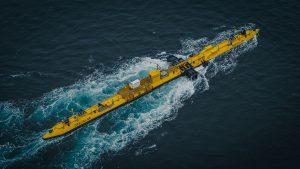
Alongside this, offshore renewables – including ocean energy – were identified as a strategic technology in the EU’s Net-Zero Industry Act, reflecting the contribution they can make to decarbonising the energy system and creating new, sustainable industries in Europe. This categorisation should translate to additional benefits, including non-price criteria in auctions and the possibility to become net-zero strategic projects, which may be granted priority status with accelerated timelines.
The EU’s dedicated strategy for offshore renewable energy includes a specific wave and tidal power deployment target of at least 1 GW by 2030, and a long-term objective of 40 GW by 2050. This strategy is now being updated and it is crucial that these targets are maintained, and even increased, as they are an important signal that ocean energy must be part of both the European and national energy mix.
EU Member States now need to step up and translate this high-level support for ocean energy into their own national energy strategies, which are currently under review.
The European Commission’s assessment of governments’ National Energy & Climate Plans (NECPs) shows there is much work to be done, stating: “There is an overall decrease in national budgets devoted to R&I in clean energy technologies and a severe lack of national objectives and funding targets that show concrete and relevant pathways to 2030 and 2050.”
The ongoing rewrite of the NECPs is a timely opportunity to introduce ambitious targets for wave and tidal energy deployments, along with roadmaps of how to deliver them. This is essential to create long-term visibility for ocean energy developers and investors, and to ensure a diverse, indigenous set of energy sources.
Europe can’t rest on its laurels
While Europe has long been the frontrunner in developing ocean energy, and has the most sophisticated ocean energy technology in the world, it is no longer alone in recognising the huge potential of the sea. Looking both to the east and the west, the past five years have seen a noticeable ramping up in activity elsewhere, including the emergence of new domestic manufacturers.
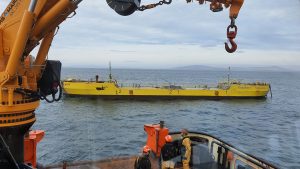
In May, the US allocated $45m to developing tidal and current energy sources, which is the U.S. Department of Energy’s largest investment in tidal energy to date. The government also awarded almost $25m of funding to wave energy technologies in early 2022. The eight winners will deploy their devices at Oregan’s new PacWave facility, due to open this autumn, and are just some of a raft of new projects expected to come online in the near future.
China’s 14th Five-Year Plan includes a specific strategy for ocean energy, with sizeable investments and a feed-in tariff driving the deployment of large-scale projects, particularly in tidal energy. One of these, from local developer LHD, has now been generating power continuously for over five years.
Further north, Canada, and in particular Nova Scotia, has been a longtime supporter of ocean energy. The jewel in its crown – the Bay of Fundy – has some of the strongest tidal flows in the world, and support in the form of a feed-in tariff and research funding have helped to attract several technology developers, with European companies among them. Earlier this year, however, a key project shut down due to federal permitting issues – much to the frustration of both the developer and the Nova Scotian government.
This experience highlights another priority topic for the ocean energy sector: permitting and consenting. Getting the money in place is one thing, but having to navigate lengthy, complex permitting procedures can also put the entire project at risk, introducing uncertainty and extra costs.
Money isn’t everything: Solving the permitting puzzle
Europe must therefore take care to avoid its political ambitions and funding commitments being undermined by a permitting bottleneck. There has been some progress on this topic – according to the International Energy Agency, more policies and regulatory changes have been instituted in Europe since the start of 2022 to ease permitting than over the entire previous decade.
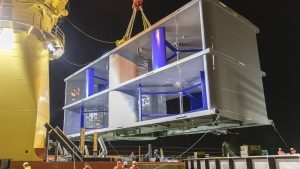
Most of those changes, however, are targeted at established renewable energy sources such as wind and solar. And it can still take up to nine years to obtain permits for an onshore wind farm. The delays caused by slow, complex procedures are having a tangible impact on how much renewable energy actually makes it into the grid. Globally, 20 GW of renewable energy capacity went unallocated via auctions in 2022, with Europe accounting for two thirds of those missed opportunities.
And while improvements to permitting processes are needed for all renewables, innovative renewables such as ocean energy need their own tailored approaches. EU Member States should make sure that ocean energy deployment targets and funding in their NECPs are paired with a review of permitting and consenting processes, so that planned projects actually make it into the water.
An optimistic outlook: The time to deliver is now
The past year has been a promising one for ocean energy worldwide, with many reasons to be optimistic. Keeping that momentum going must be a high priority for both the EU and national European governments. Long-term visibility, political and financial, is what will transform projects from being good on paper to great in practice. The ocean energy sector is ready, its technologies are waiting to find a home at sea – and there are only advantages on the horizon for Europe and its citizens.
Please note, this article will also appear in the fifteenth edition of our quarterly publication.

